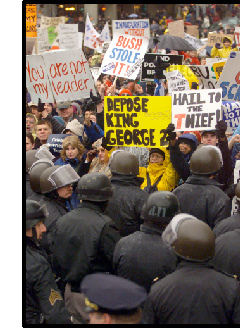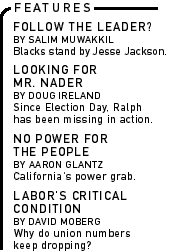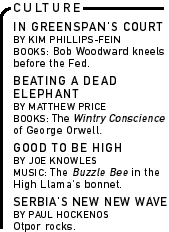|
Presidential inaugurations are a peculiar combination of civic
ecstasy and the celebration of raw power--like enthralled high-school
students on field trips watching a Soviet May Day-style parade for
corporate democracy. There's the ostentatious swearing-in ceremony,
the Pennsylvania Avenue procession of floats, marching bands and
military hardware, the sharpshooters on the roofs, and the stretch
limos pulling up to a bazillion-dollars-per-ticket gala inaugural
ball.
All these festivities are a self-congratulatory public reminder
that "We Are The Greatest Government In The History Of The World."
Privately, meanwhile, Inauguration Day is a series of wild parties
for whichever clique will be pillaging taxpayers for the next four
years. For more sober observers, it's all just a reminder that while
you can watch once every four years for a few hours, Washington
power is really an ongoing series of parties to which you're not
invited.
All modern-day U.S. inaugurations, regardless of the victorious
party, are like this.
 |
|
Protesters confront the passing
presidential limo.
KEVIN LAMARQUE/REUTERS
|
George W. Bush's 2001 bash, however, had a third element, an uninvited
and largely unreported one, as studiously ignored by other party-goers
as a loudly drunk neighbor the hosts hope will simply go home. Among
the estimated 300,000 people that gathered in the light rain at the
Capitol and along Pennsylvania Avenue, tens of thousands of people
expressed their belief that the whole thing was a fraud. It was the
largest inaugural protest since Nixon. In 1973, anti-inaugural crowds,
assembling far away from the parade, were swelled by a well-organized
movement angered by an unpopular war. This year, there was no such
organization and Dubya hadn't even had a chance to step in the Oval
Office with his new boots yet.
But the protesters came from near and far, and, unlike 1973, they
could get up close to Pennsylvania Avenue--thanks to a 1997 court
ruling allowing anti-abortion groups access to Bill Clinton's parade.
This year at least 20 mostly obscure groups planned protests. They
announced five different, distinct locations (or just "along Pennsylvania
Avenue") at which confused anti-Bush citizens could assemble.
Only five weeks earlier, Al Gore's supporters, buoyed by the Florida
Supreme Court ruling, believed they'd be the ones marching and partying.
Instead, they were shivering, waving signs like "Count My Vote"
and "Hail to the Thief," marginalized by the pervasive security
and uninterested networks. Alongside them were many others concerned
about a variety of issues that transcended Gore and Bush. The dozens
of causes all melded into one message, unmistakably delivered in
block after block of the parade route: As president, Bush has no
right to pursue the right-wing policies he wants. He is, according
to the words of one memorable sign, the illegitimate son.
It was difficult to gauge the actual size of the anti-Bush demonstrations,
and so mostly the networks, reporters and pundits didn't even try.
They were content to mention it in passing, like some unfortunate,
unavoidable irritant--and content to get comments from appalled
Bush supporters and to adopt the Republican thesis that these were
"sore losers." If so, the losers were everywhere, making up a large
percentage, and in many places a majority, of the crowd.
In Bush's uninspiring, meandering, flatly delivered inaugural speech--evoking
nothing so much as a teen-ager rendering the homework assignment
his clueless father penned late the previous night--he mentioned
citizens sometimes seeming to "share a continent, not a country,"
a reference that could as easily refer to his divisive policy proposals.
That was the new president's only gesture toward Americans embittered
by the way he won the election. If anything, the prominent ceremonial
role played by Sen. Mitch McConnell (R-Kentucky), husband of Labor
Secretary Elaine Chao and the primary architect of all opposition
to campaign finance reform, suggested Dubya's contempt for the entire
topic of electoral reform, and a fundamental lack of concern for
"healing."
The parade route was littered with people who will remember that
lack of concern. As the Bushes rode and then walked up Pennsylvania
Avenue, they passed solidly pro-Bush bleachers (these were the paid
tickets, at $50 and up), alternating with blocks that were either
mixed or--especially close to the White House--solidly anti-Bush.
Somehow, this became, according to one radio reporter, "hundreds
of protesters"; according to most others, a few thousand. The Washington
Post managed to work in the familiar reference to protesters'
piercings. But the anti-Bush signs were much more widespread, and
their bearers more demographically varied, than most inaugural coverage
suggested.
The inauguration's unprecedented heavy security--the Secret Service
surrounded the parade route with ten security checkpoints all parade-goers
had to pass through--was mounted in large part because nobody knew
what to expect. As it turned out, the massive police presence was
unnecessary, and the protests were exactly as advertised: an almost
entirely peaceful display of opposition to Bush. Somehow, the lack
of conflict between police and protesters, and the lack of prominent
names attached to their cause, made the protesters' message less
important to reporters.
Such dismissiveness both missed the point and the significance
of the demonstrations, and starkly showed how difficult it will
be for citizen groups alarmed by one or another Bush policy in the
next four years to be heard. With the exception of the National
Organization for Women--which comprised a boisterous pro-choice
cluster between 8th and 9th Streets--the traditional Democratic
Party constituencies one would expect to protest both the election
and Bush's prospective policies were strikingly absent. There was
no labor or environmental presence at all. Even vocal election critics
like Jesse Jackson had taken a pass; before his personal scandal
erupted, Jackson had planned to attend a rally in Tallahassee, far
away from the cameras.
Instead, the election-themed protesters were mobilized through
the Internet by vaporous "groups" like Votermarch.org and Countercoup.org,
entities that had never met face-to-face and had come together expressly
for the purpose of protesting the inauguration. Further to the left,
organizers like the Justice Action Movement, the International Action
Center and the media celebrity Rev. Al Sharpton helped bring people
to Washington. But they sported few, if any, "followers" in the
traditional sense.
The lack of organizational backing made these protests more impressive,
not less. There was no legislation pending, no war raging, no recession
(so far). And all the "sponsors" did was provide permits. Yet tens
of thousands of dissenters found their way to Washington on their
own volition, and without any apparent policy goal beyond the desire
to display opposition to a regime that had not yet even taken office.
And in Seattle, San Francisco and Los Angeles, thousands more also
protested.
Opponents of Dubya's policies will remember this--and they will
remember that after having the election yanked out from under them,
congressional Democrats have displayed almost no opposition to an
array of Bush cabinet nominees that is anything but moderate and
bipartisan. There is a potentially powerful movement brewing. But
nobody is harnessing it, and nobody in power is championing it.
Yet. 
|





